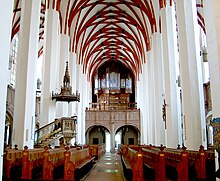Singet dem Herrn ein neues Lied, BWV 190
| Singet dem Herrn ein neues Lied | |
|---|---|
| BWV 190 | |
| Church cantata by J. S. Bach | |

Thomaskirche, Leipzig
|
|
| Related | base for BWV 190a |
| Occasion | New Year's Day |
| Performed | 1 January 1724: Leipzig |
| Movements | 7 |
| Cantata text | anonymous |
| Bible text |
|
| Chorale | |
| Vocal |
|
| Instrumental |
|
Singet dem Herrn ein neues Lied (Sing a new song to the Lord),BWV 190, is a church cantata by Johann Sebastian Bach. He wrote it in Leipzig for the New Year's Day and first performed it on 1 January 1724 as part of his first cantata cycle. He adapted it in 1730 to Singet dem Herrn ein neues Lied, BWV 190a, for the celebration of the bicentennial of the Augsburg Confession.
Bach wrote the cantata in 1723, his first year as Thomaskantor in Leipzig, for New Year's Day, which is also the Feast of the Circumcision of Christ. The prescribed readings for the feast day were from the Epistle to the Galatians, by faith we inherit (), and from the Gospel of Luke, the circumcision and naming of Jesus eight days after his birth (). The unknown poet, possibly Picander, refers only in a general way to the readings: he mentions the naming at the end of movement 4, "Jesu Namen" (name of Jesus), and he starts every line in the following aria with "Jesus". Otherwise the text stresses praise and thanks for the gifts of the past and prayer for further blessings. The poet compiled for the opening chorus three verses from Psalms, and , and in between the first two lines of Martin Luther's "Deutsches Tedeum" (German Te Deum) "Herr Gott, dich loben wir" (Lord God, Thee we praise). The words from the "Te Deum" appear again in the second movement, interspersed by recitative. The closing chorale is the second stanza of Johannes Hermann's "Jesu, nun sei gepreiset" (1591).
...
Wikipedia
